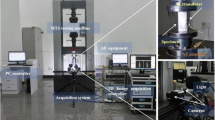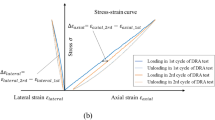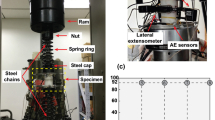Abstract
In this study the possibilities of the acoustic emission (AE) technique and deformation rate analysis (DRA) were investigated to measure in situ rock stress. The rock cores were obtained from three vertically drilled exploratory boreholes from the surface and one borehole drilled from within an underground coal mine. The AE method was found to determine in situ rock stress with reasonable accuracy using AE signatures in repeated loadings of a rock core specimen. Based on the results of in situ stress estimation from the AE method, the time interval, up to seven years, did not strongly influence the previous stress determination using the AE method. Cored rock recollected the in situ stress condition reasonably well (within ±10%), when compared to the results from over coring and hydraulic fracturing technique. Also, there was significant correlation between overburden pressure and estimated vertical stress from the AE method.
Similar content being viewed by others
References
Enever, J. and Doyle, R. (1996) The role of horizontal stress in longwall design — a case history at Dartbrook Colliery, NSW, Proc. Symp. on Geology in Longwall Mining, Sydney, Australia, pp. 143-151.
Houghton, D.R. and Crawford, A.M. (1987) Kaiser effect gauging: The influence of confining stress on its response, Proc. 6th ISRM Congress, Montreal, Canada, Vol. 2, pp. 981-985.
Holcomb, D.J. and Stevens, J.L. (1980) The reversible Griffith crack: A variable model for dilatancy, J. Geophys. Res., 85, 7101-7107.
Holcomb, D.J. (1993) Observations of the Kaiser effect under multiaxial stress state: Implications for its use in determining in situ stress, Geophys. Res. Lett., 20, 2119-2122.
Kanagawa, T., Hayashi, M. and Nakasa, H. (1976) Estimation of spatial geostress components in rock samples using the Kaiser effect of acoustic emission, Rep. No. 375017, Central Res. Inst. of Electrical Power Industry, Abiko, Japan.
Kurita, K. and Fujii, N. (1979) Stress memory of crystalline rock in acoustic emission, Geophys. Res. Lett., 6, 9-12.
Momeyez, M. and Hassani, F.P. (1992) Application of Kaiser effect to measure in-situ stresses in underground mines, Rock Mechanics, Tillerson and Wawersik (eds), Balkema, Rotterdam, pp. 979-987.
Seto, M., Utagawa, M. and Katsuyama, K. (1989) Estimation of geostress from AE characteristics in cyclic loading of rock (in Japanese), Proc. 8th Japan Symp. on Rock Mechanics, The Japan National Committee for ISRM, Tokyo, Japan, pp. 321-326.
Seto, M., Utagawa, M. and Katsuyama, K. (1992) The estimation of pre-stress from AE in cyclic loading of pre-stressed rock, Proc. 11th Int. Symp. on Acoustic Emission, The Japanese Society for NDI, Fukuoka, Japan, pp. 159-166.
Seto, M., Utagawa, M. and Katsuyama, K. (1995) The relation between the variation of AE hypocenters and the Kaiser effect of Shirahama sandstone, Proc. 8th Int. Cong. on Rock Mechanics, Vol. 1, Tokyo, Japan, pp. 201-205.
Siegfried, R. and Simmons, G. (1978) Characterization of oriented cracks with differential analysis, J. Geophys. Res., 83, 1269-1278.
Simmons, G., Siegfried, R. and Feves, M. (1974) Differential strain analysis: new method for examining cracks in rocks, J. Geophys. Res., 79, 4383-4385.
Utagawa, M., Seto, M. and Katsuyama, K. (1995) Application of acoustic emission technique to determination of in situ stresses in mines, Proc. 26th Int. Conf. Safety in Mines Research Institute Vol. 4, Central Mining Institute, Katowice, Poland, pp. 95-109.
Yamamoto, K., Kuwahara, Y., Kato, N. and Hirasawa, T. (1990) Deformation rate analysis: a new method for in situ stress examination from inelastic deformation of rock samples under uni-axial compressions, Tohoku Geophys. J., 33, 127-147.
Yoshikawa, S. and Mogi, K. (1981) A new method for estimation of the crustal stress from cored rock samples: Laboratory study in the case of uniaxial compression, Tectonophysics, 74, 323-339.
Yoshikawa, S. and Mogi, K. (1989) Experimental studies on the effect of stress history on acoustic emission activity — A possibility for estimation of rock stress, J. of Acoustic Emission, Vol. 8,No. 4, pp. 113-123.
Author information
Authors and Affiliations
Rights and permissions
About this article
Cite this article
Seto, M., Nag, D. & Vutukuri, V. In-situ rock stress measurement from rock cores using the acoustic emission method and deformation rate analysis. Geotechnical and Geological Engineering 17, 241–266 (1999). https://doi.org/10.1023/A:1008981727366
Issue Date:
DOI: https://doi.org/10.1023/A:1008981727366




